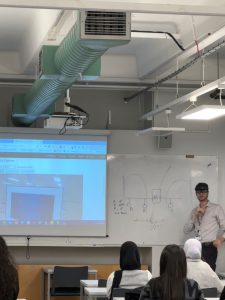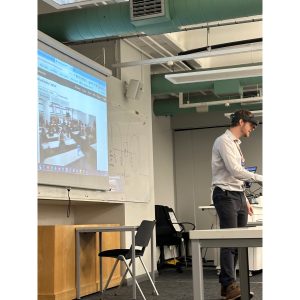The Technology Enhanced Learning Team (TELT) have recently been exploring innovative and immersive learning techniques. Both in and out of the classroom, TELT have been working with several QMUL academics to analyse the impact technologies can have on student engagement and collaboration.
Working alongside colleagues such as Gwijde Maegherman (SBBS) is paramount to ensuring technologies are making a tangible difference to teaching and learning practices. Gwijde first tested TELT’s HoloLens’ augmented/mixed reality (AR/MR) device in Cognitive Psychology lectures, complementing discussions on laws of perception and visual processes and how these can be used to make technology more intuitive and computing more accessible. As such, AR/MR merges perceptual principles described over the past 200 years with modern technology and resulting in students excited to learn about immersive lecture content on a device they would not ordinarily have access to.

Gwijde expertly used the headset’s built-in eye-tracking capabilities to provide students with innovative examples of overt and covert attention, and to showcase the power of eye-tracking as a research method. This would ordinarily involve small student groups coming into the lab to see highly specialised and expensive equipment for a few minutes, but with the HoloLens, Gwijde was able to seamlessly switch to an immersive demonstration and provide students the opportunity to assess eye-tracking themselves with minimum set-up time.
Gwijde also took the opportunity to showcase AR/MR to around 100 A-Levels students who attended an open/outreach day, where he explained the concepts of bottom-up (visual stimuli) and top-down (knowledge and expectation) processes using examples of virtual items in the classroom. Students were shown virtual items placed on desks and walls which were revealed through the HoloLens and these virtual objects were manipulated in line with physical laws, such as a virtual lamp standing on a desk and not being able to pass through it. Using these examples, Gwijde explained to students how our visual sensations come together with our expectations of the physical world to provide the best understanding and experience of a visual percept.
“Students have always been enthusiastic to try it and to merge the learned content with practical applications. As AR/MR and spatial computing become the next revolution in how we interact with technology, providing students with examples of how their understanding of cognitive psychology concepts is useful in real-world applications is extremely valuable. At the same time, showcasing the university’s efforts to provide students with access to these technologies as they emerge, helps cement the university’s commitment to inclusivity to both current and prospective students. Without help from Zaheer and TELT, these valuable learning opportunities would not have been possible.”
– Gwijde Maegherman
School of Biological and Behavioural Sciences (Science and Engineering)
Through increased partnership between SBBS and TELT, we hope to make AR/MR an innovative learning method throughout the course in the next academic year. We’re currently investigating several more technological solutions to meet the needs of our academic professionals and their students, and look forward to showcasing them soon.
Article Co-written: Zaheer Daleel (TEL Enhancement Manager) & Gwijde Maegherman (Psychology Lecturer)
Do you have a tech-based idea for improving teaching and learning practices?
Want to hear more about TELT’s enhancement work and innovative projects?
Get in touch with TELT (telt@qmul.ac.uk) or Zaheer directly for more information.



